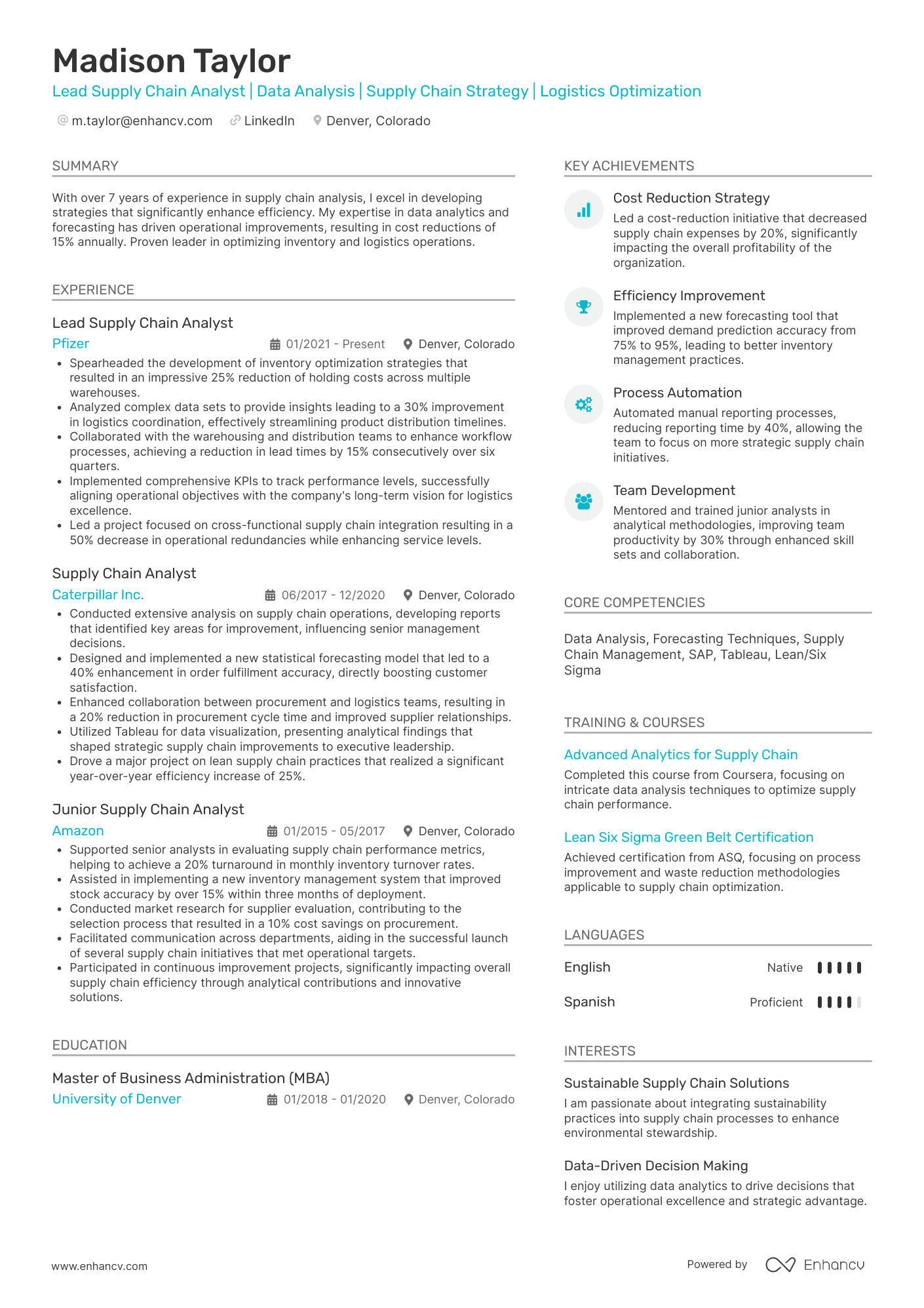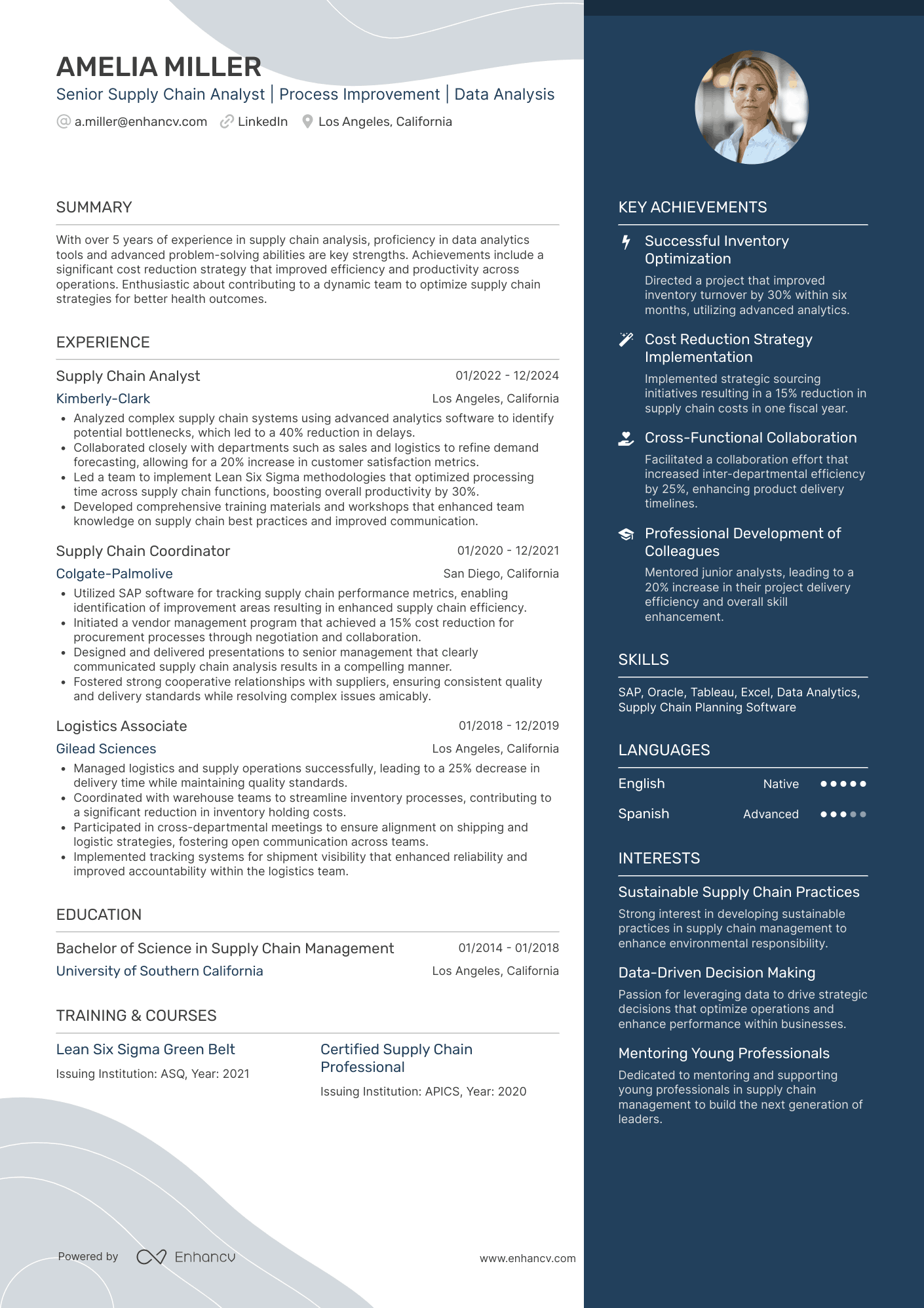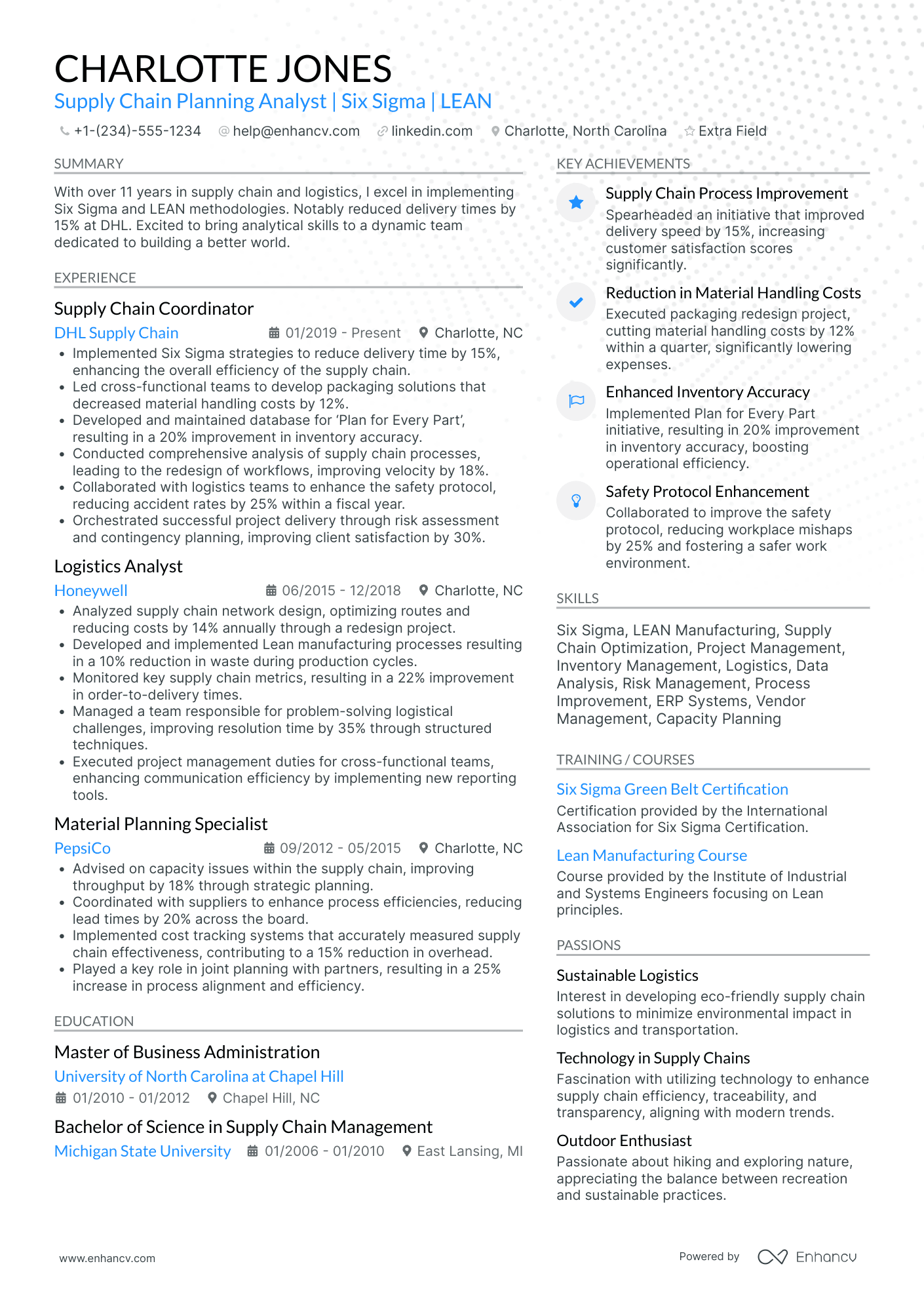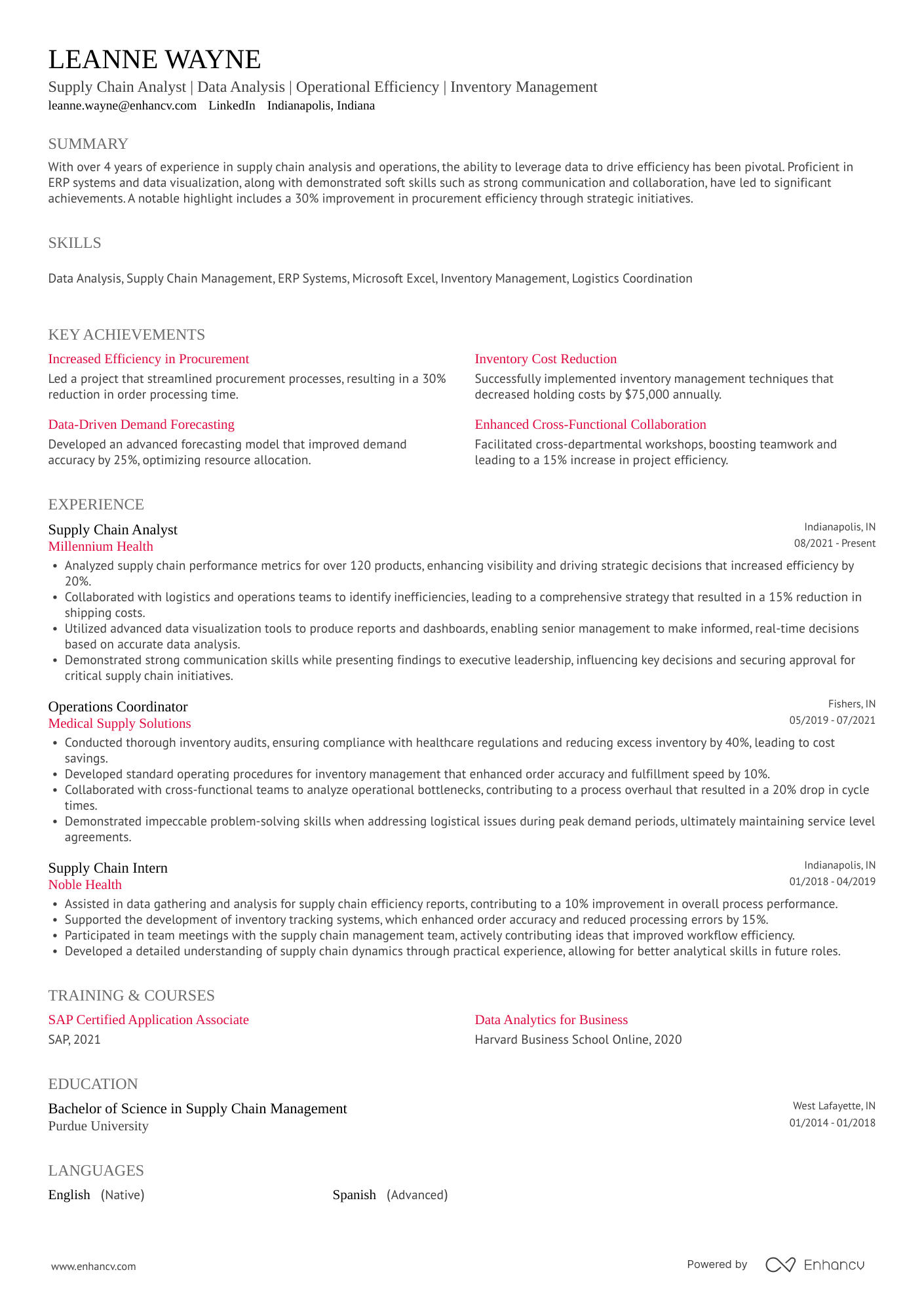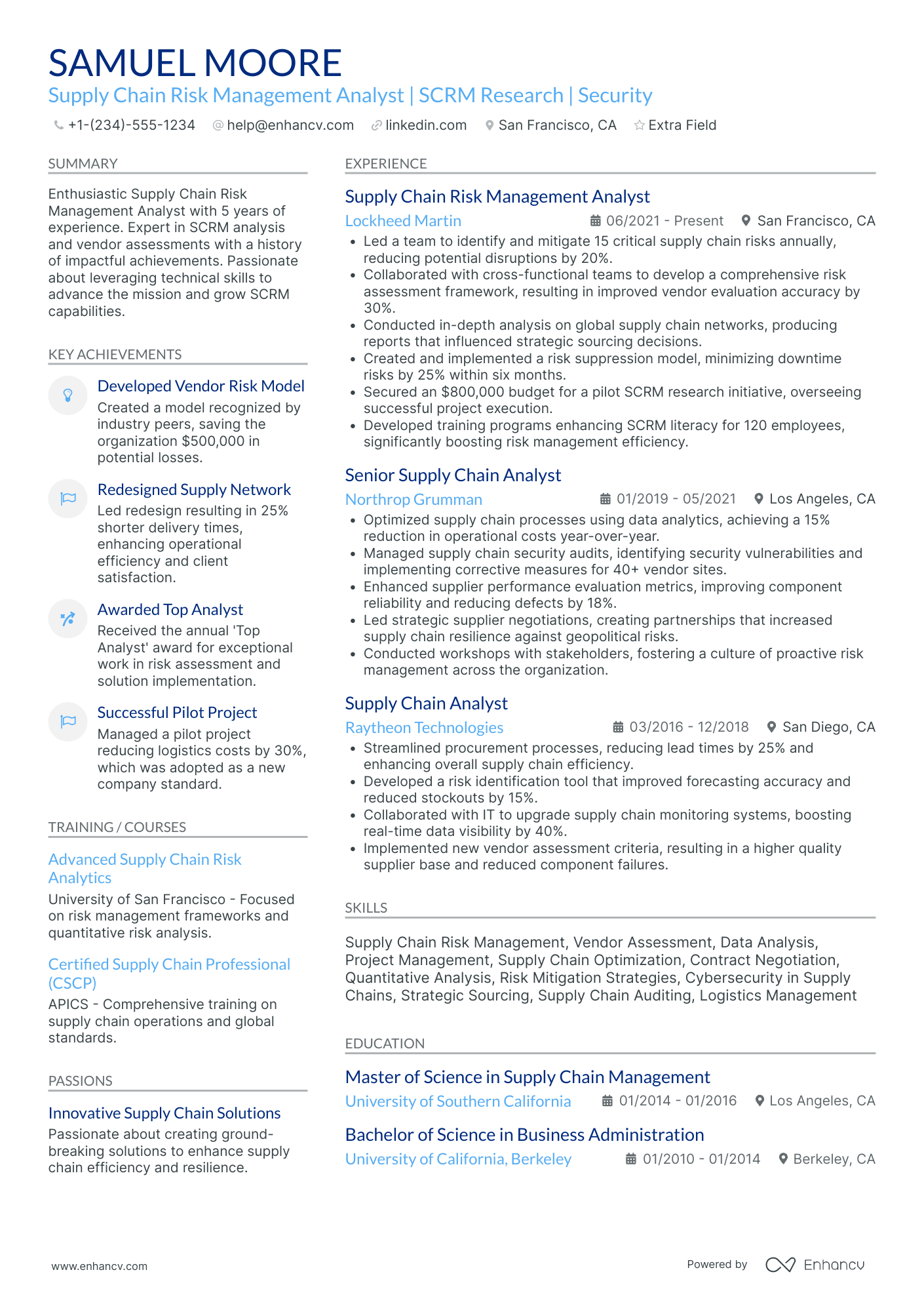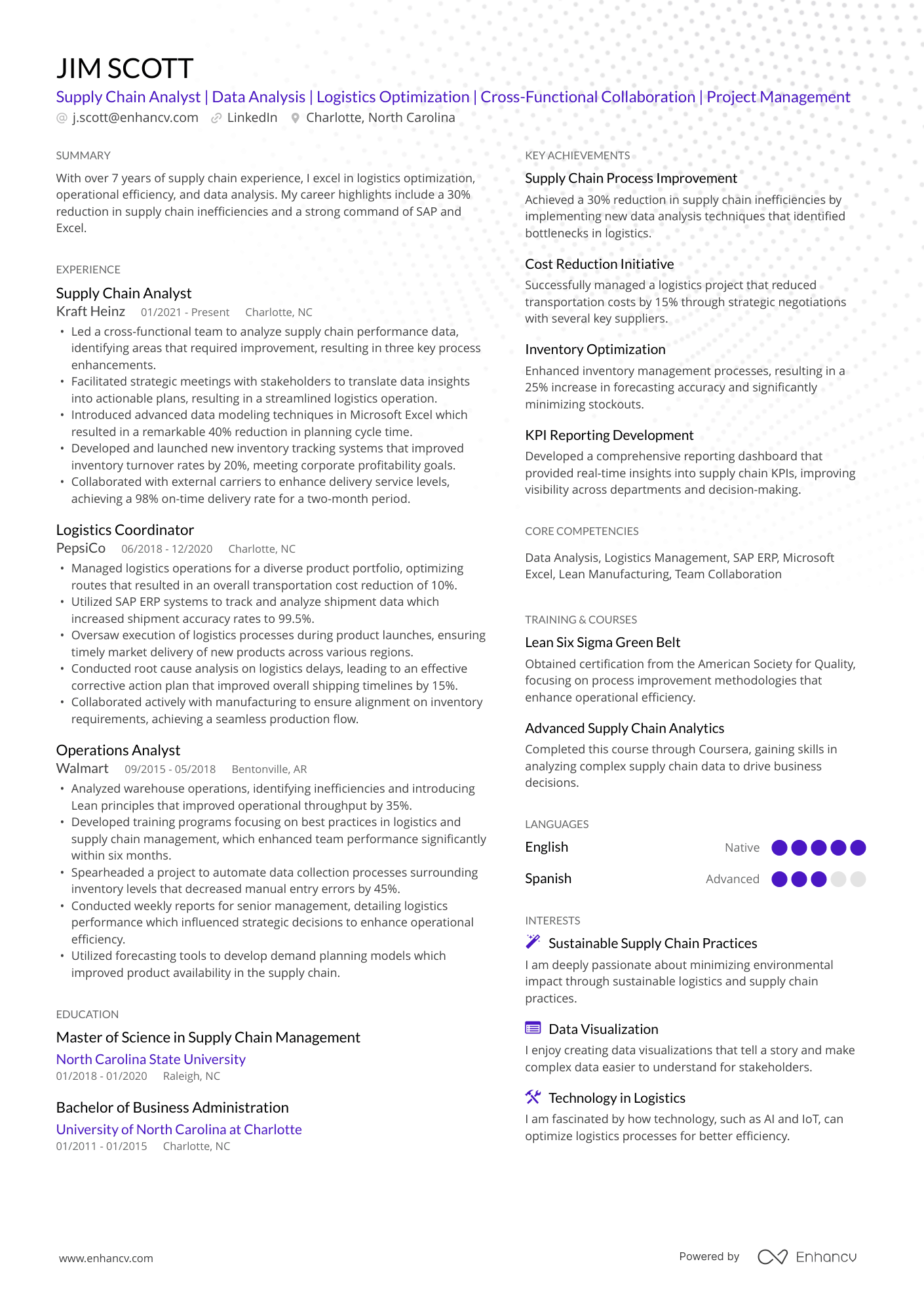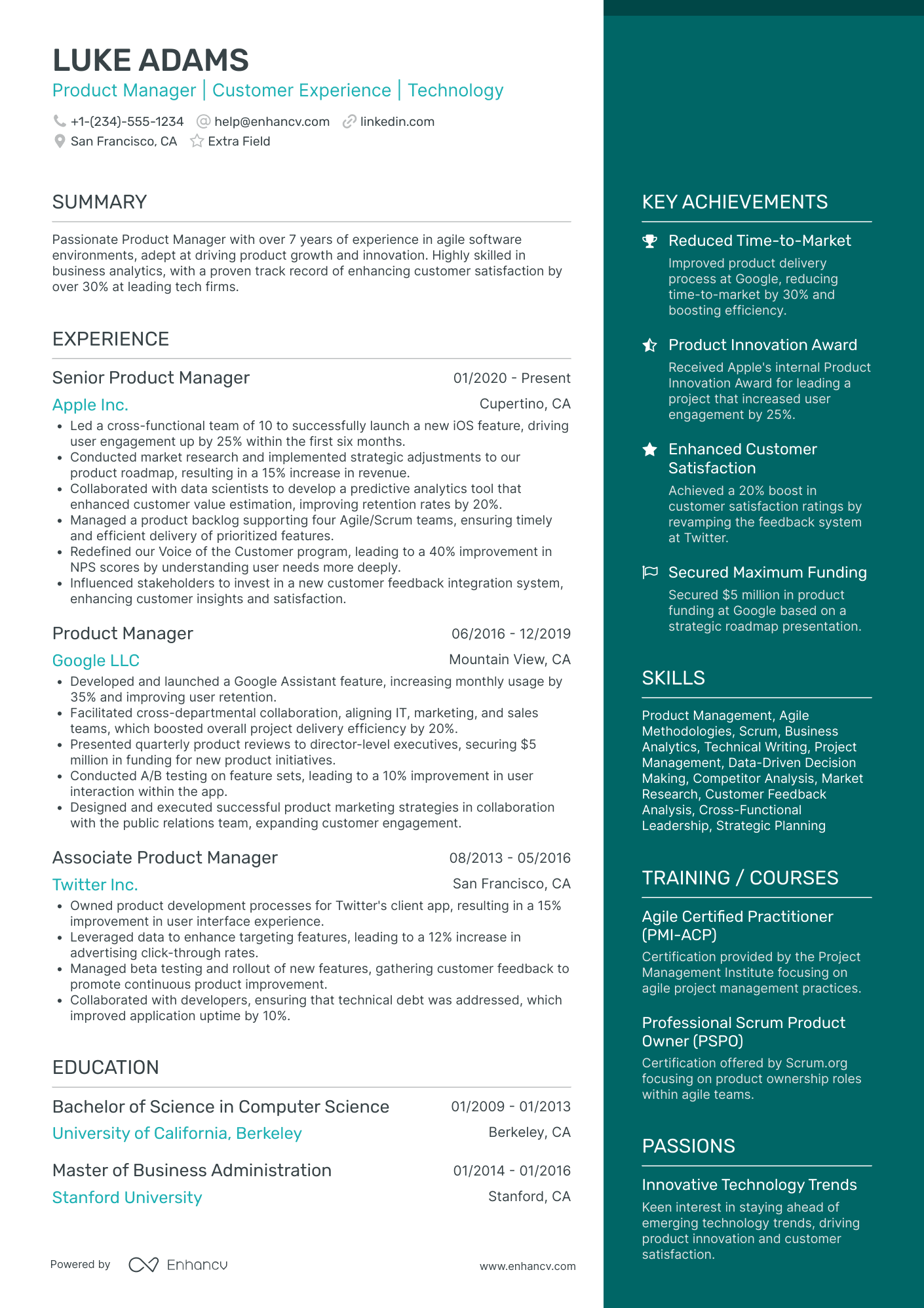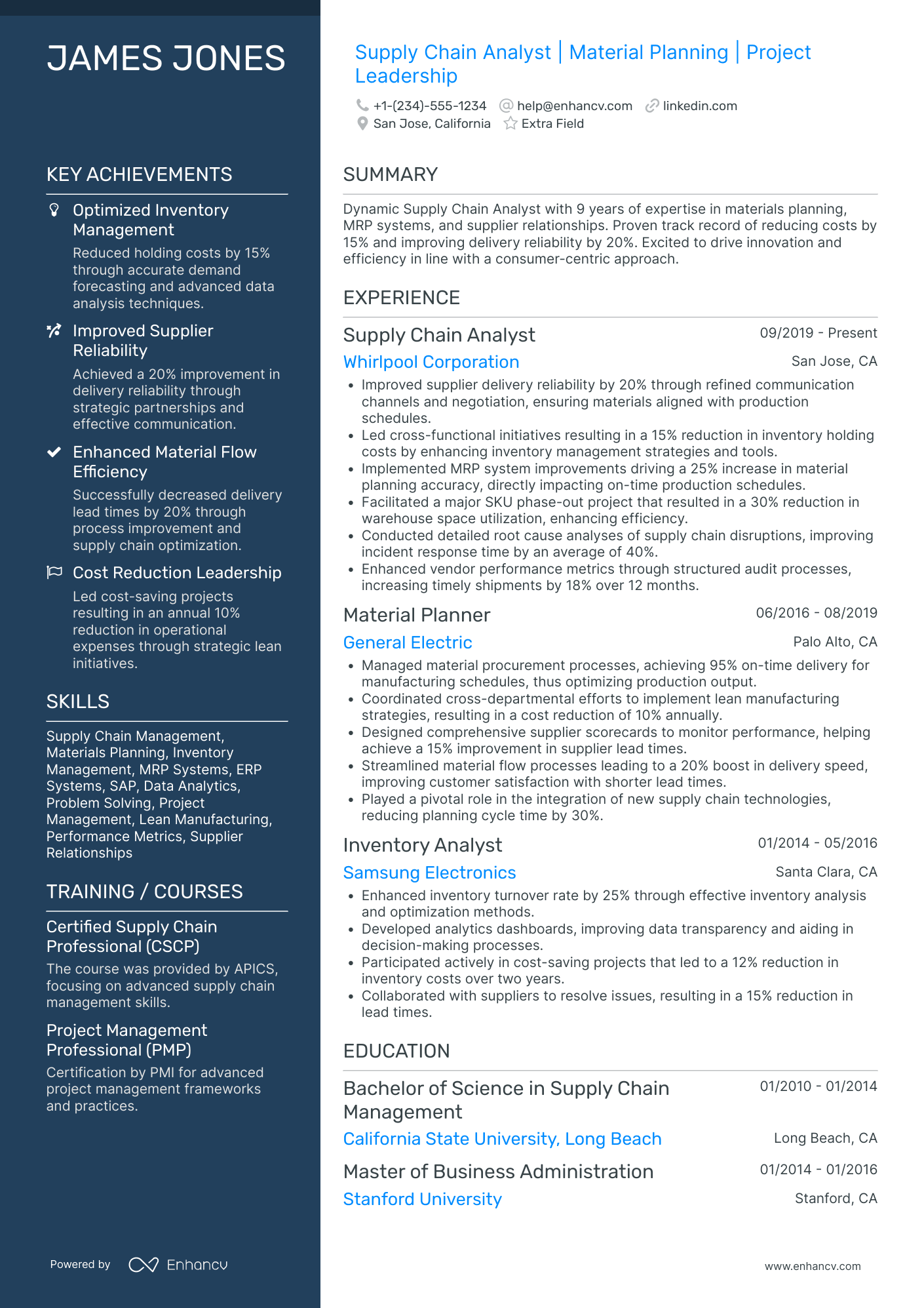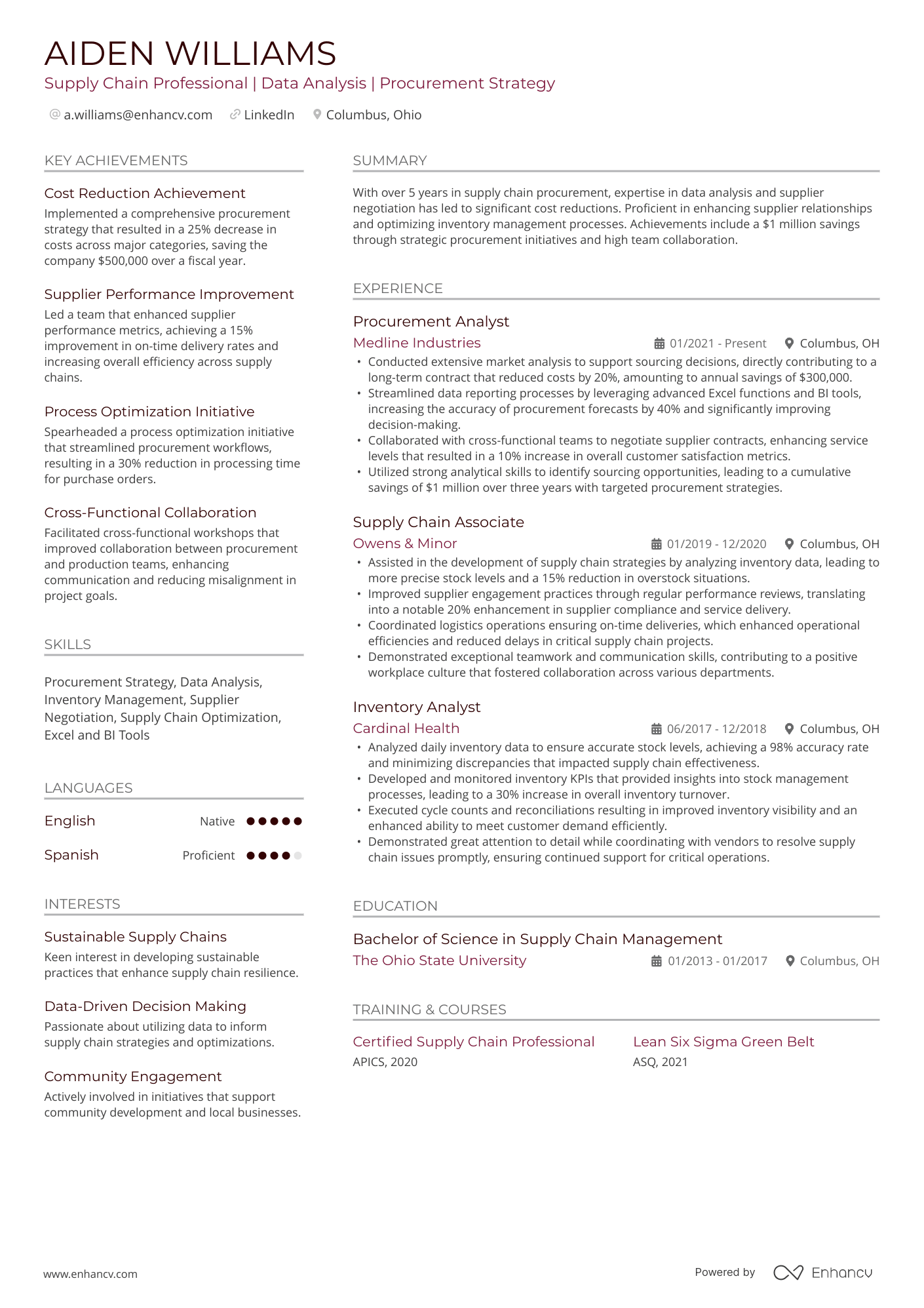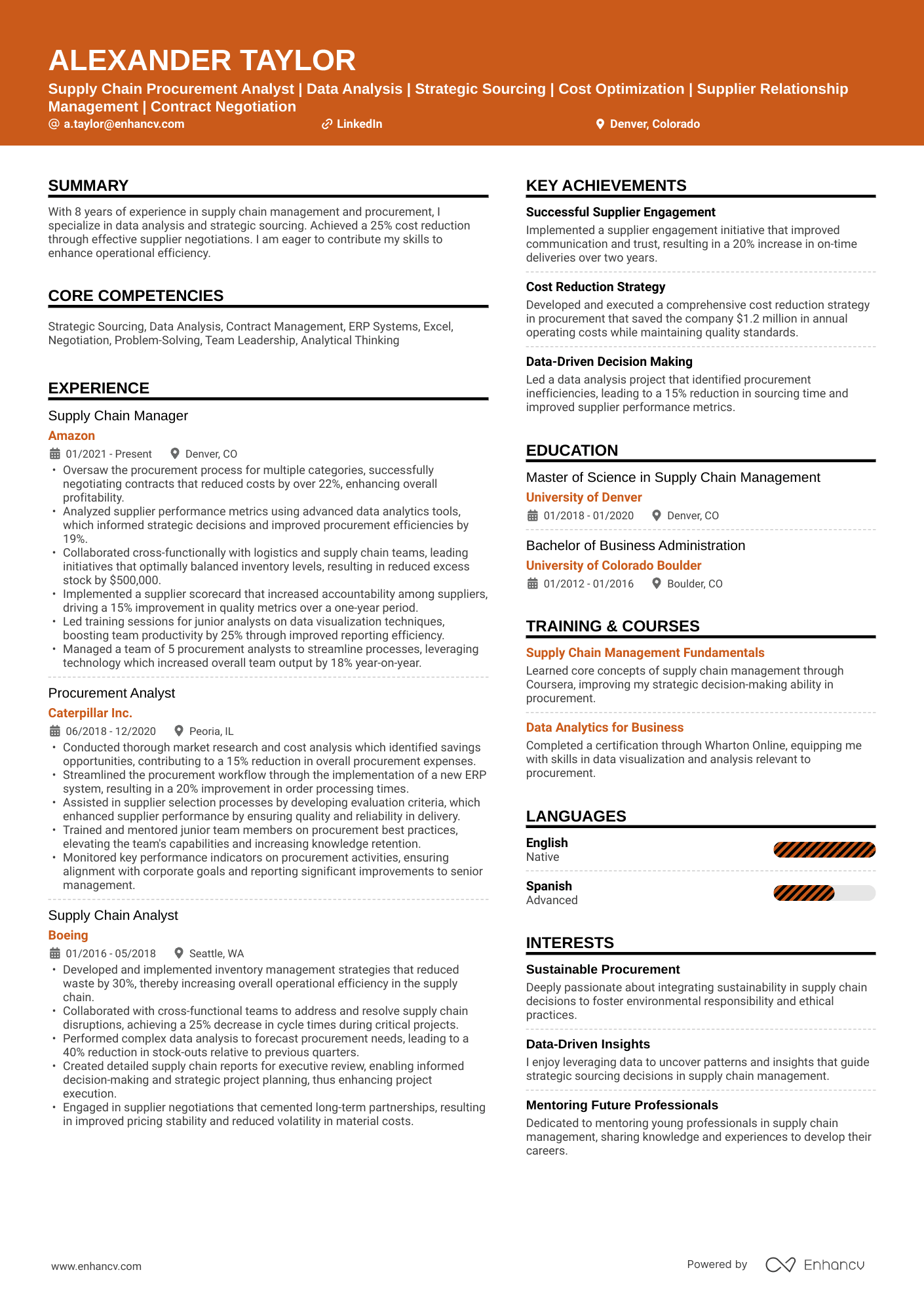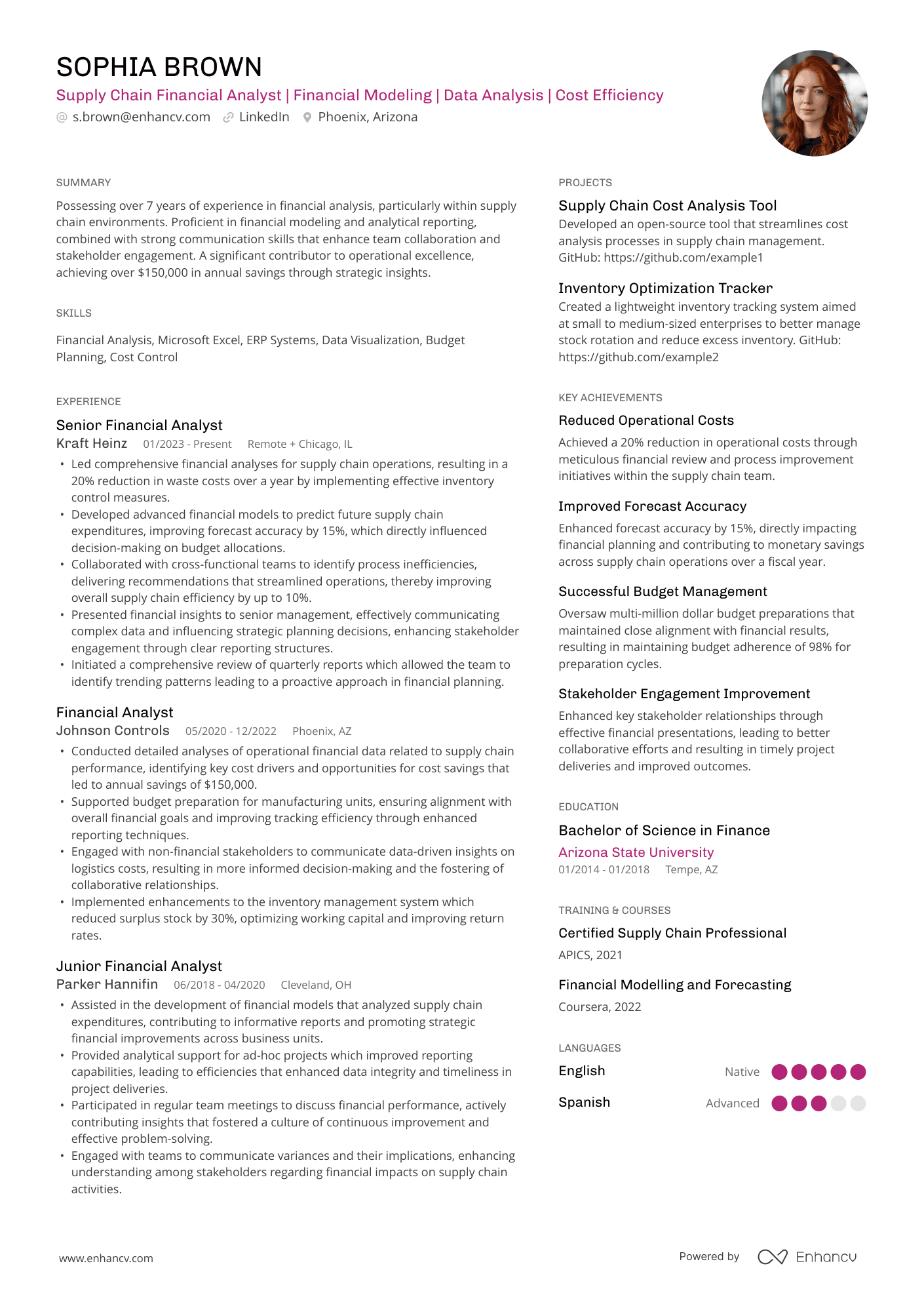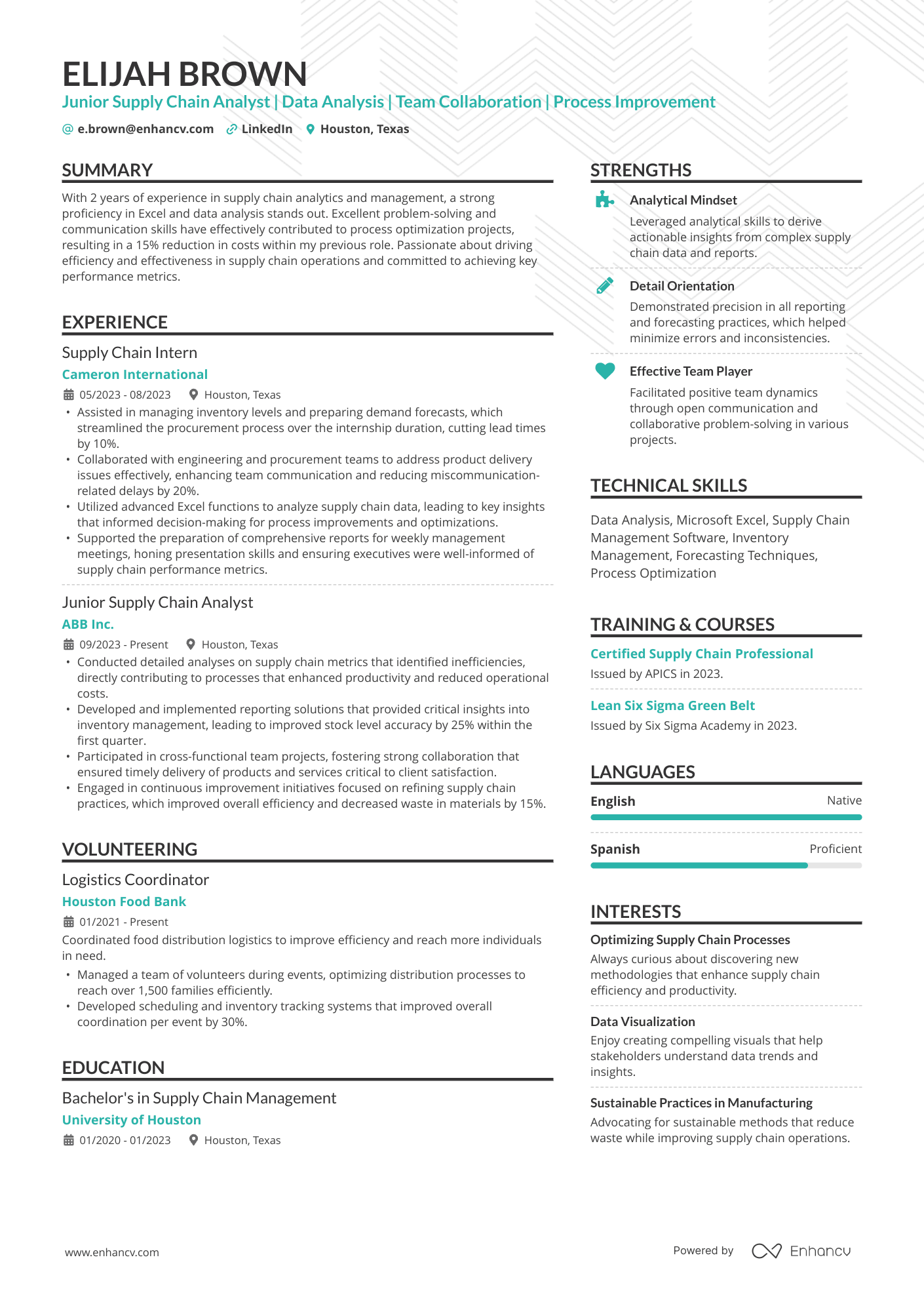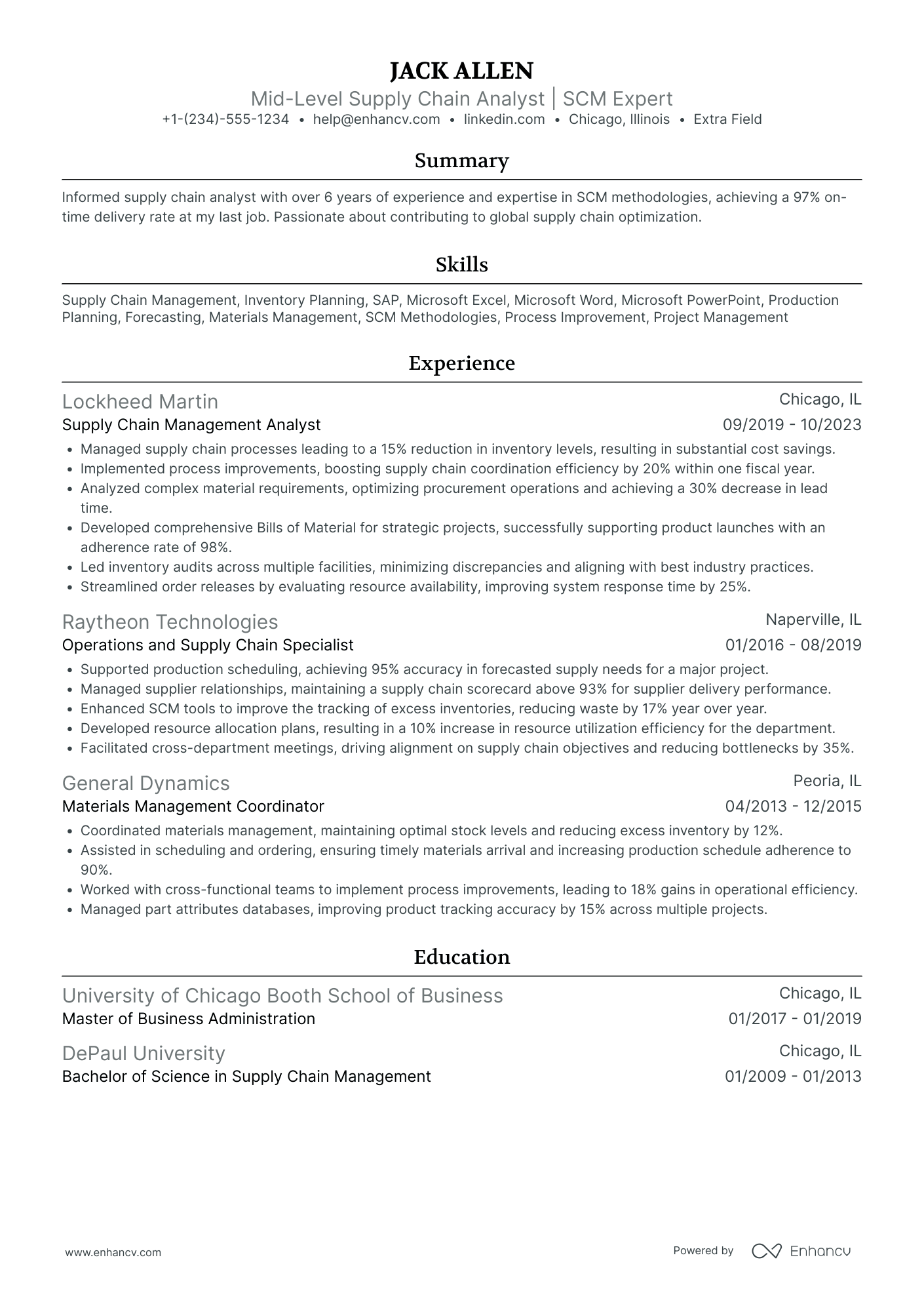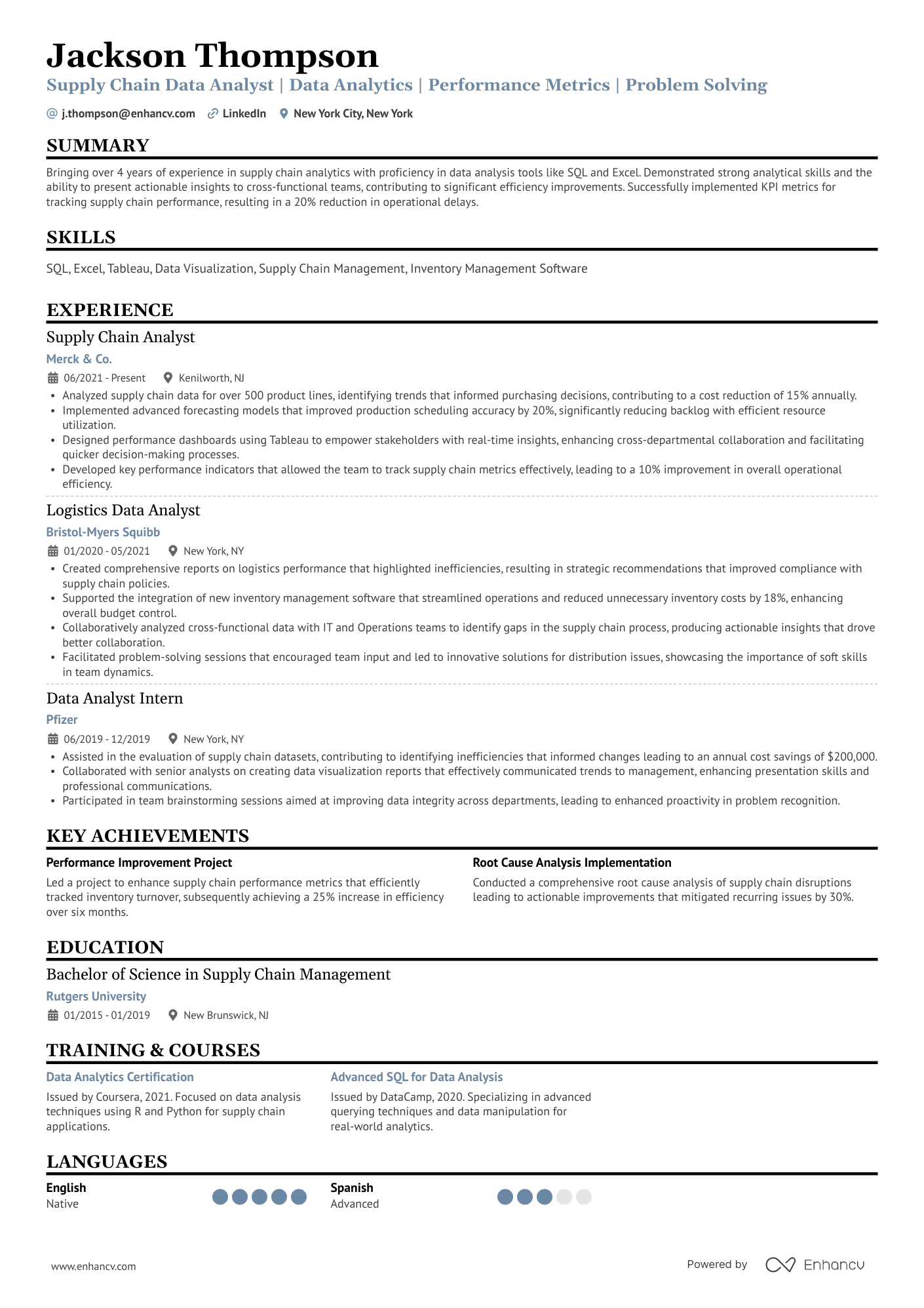Think of your resume as your own logistics network—every word should move the recruiter closer to saying “yes.”
Each section needs to flow with purpose, every skill should add value, and your achievements should arrive right on time. This guide shows you how to design a resume that runs as smoothly and efficiently as the supply chains you help optimize.
As Certified Professional Résumé Writers (CPRWs) and career experts who’ve helped thousands of people land interviews at global companies, we’ll walk you through proven strategies and real examples—so you can create a resume that serves your needs.
Key takeaways
- Use a professional reverse-chronological format—recruiters value precision and organization.
- Start with a results-focused summary that quantifies achievements.
- Highlight data, forecasting, and ERP skills—these drive hiring decisions.
- Include certifications like APICS CSCP or Lean Six Sigma for credibility.
- Spotlight projects and coursework if you’re entry-level or changing careers.
- Keep design clean, numbers visible, and your impact unmistakable.
Let’s explore a few supply chain analyst examples to get the feel of your preferred layout and tone.
Get inspired by these supply chain analyst resumes
By Experience
Lead Supply Chain Analyst
Junior Supply Chain Analyst
Senior Supply Chain Analyst
By Role
Supply Chain Planning Analyst
- Demonstrates expertise with sector keywords and concepts – An outstanding Supply Chain Planning Analyst resume seamlessly incorporates relevant terminology such as demand forecasting, S&OP, inventory optimization, MRP, and ERP proficiency, reflecting both technical fluency and a deep understanding of the field’s core processes and technologies.
- Conveys clear intent and professional drive – A compelling application explains not just experience but also the candidate’s enthusiasm for supply chain analytics, highlighting a desire to drive efficiencies, leverage data-driven insights, and contribute meaningfully to organizational performance through meticulous planning and cross-functional collaboration.
- Presents information in a clean and accessible format – Effective spacing, judicious use of bullet points, concise sections, and consistent font usage ensure the resume is easy to scan, allowing recruiters to swiftly locate key qualifications and achievements without visual clutter or lengthy, dense paragraphs.
Global Supply Chain Analyst
- Expressing purposeful ambition – An impactful Global Supply Chain Analyst resume shows the candidate’s genuine enthusiasm for optimizing worldwide logistics, clearly communicating how their interest in complex global operations motivates them to drive efficient, data-backed solutions within the prospective employer’s network.
- Weaving career story into future potential – Distinctive resumes demonstrate how a candidate’s previous roles—such as analyzing supply chain metrics, reducing inventory costs, or managing cross-border shipments—directly reinforce their competency and readiness for the analytical demands and global scope of the position they’re applying for.
- Concluding with confident action – Standout resumes finish with a convincing closing section that not only summarizes the candidate’s alignment with the company’s mission but also proactively invites the employer to initiate further discussion, leaving a lasting impression of resourcefulness and drive.
Supply Chain Optimization Analyst
Supply Chain Risk Analyst
- Distinctive summary that captures core expertise – An attention-grabbing introduction for a Supply Chain Risk Analyst resume combines concise personal branding with a spotlight on key risk management capabilities, such as quantifying vulnerabilities and deploying mitigation strategies. This section quickly tells the reader why the candidate stands out, providing a compelling snapshot tailored to the world of supply chain risk analysis.
- Recognition of impactful contributions – Highlighted achievements that clearly relate to minimizing supply disruptions, improving supplier risk assessments, or driving cost-effective compliance set an individual apart. Specific metrics—such as percentage reductions in losses or successful development of risk monitoring tools—demonstrate real-world results vital to this profession.
- Powerful closing that prompts employer engagement – Closing remarks that communicate initiative, express enthusiasm for addressing complex risk challenges, and proactively invite further discussion show the candidate’s commitment and professionalism. This ending motivates hiring managers to take the next step and signals readiness to deliver value from day one.
Supply Chain Operations Analyst
Supply Chain Data Analyst
Supply Chain Logistics Analyst
Supply Chain Inventory Analyst
- Unified professional image across platforms – A standout Supply Chain Inventory Analyst resume maintains alignment with the candidate’s LinkedIn profile, showcasing a coherent narrative of expertise, quantifiable successes, and core competencies specific to inventory management, which builds trust with recruiters seeking authenticity and reliability.
- Compelling introduction tailored to the field – The most effective resumes immediately capture attention with an opening that concisely highlights expertise in inventory optimization, data analysis, and familiarity with key industry software, setting a focused tone that signals a deep understanding of supply chain operations right from the start.
- Immediate sense of fit for the position – Upon reviewing the document, hiring managers are presented with a clear display of both analytical capability and results-driven experience, making it easy to envision the candidate excelling in inventory forecasting and process improvement responsibilities central to the role.
Supply Chain Cost Analyst
- Showcased, quantifiable wins – Demonstrating a consistent record of optimizing supply chain expenditures, such as by highlighting how specific initiatives delivered measurable cost reductions or increased efficiency, instantly sets a resume apart with concrete proof of the analyst’s influence on the bottom line.
- Compelling introduction reflecting expertise – A resume that launches with a powerful summary tying together years of analytical experience, industry-focused knowledge, and direct alignment to the employer’s needs draws in the reader and immediately underscores the candidate’s suitability for a supply chain cost analysis role.
- Depth in analytical tools and methodologies – Detailing proficiency in ERP systems, advanced Excel modeling, and cost accounting strategies demonstrates the applicant’s capability to not only understand complex data but also to drive informed decisions, signaling both technical and professional mastery relevant to the field.
Supply Chain Systems Analyst
Supply Chain Procurement Analyst
Supply Chain Financial Analyst
Supply Chain Performance Analyst
How to choose the best supply chain analyst resume format
The right format will communicate your strengths to the employer quickly and efficiently.
The industry standard for supply chain analysts is a reverse-chronological format. It highlights your most recent data-driven achievements first, so it’s ideal for showing career growth and operational impact.
If you’re transitioning into supply chain from another field (like finance or operations), a combination format also works well—allowing you to emphasize transferable skills before diving into your work history.
What sections should go on a supply chain analyst resume?
With your format in place, let’s see what the essential sections for a supply chain analyst resume are:
- Header (Name, Contact Info, LinkedIn)
- Professional summary
- Experience
- Education
- Skills
- Certifications
- Achievements or Projects (optional but highly effective for showcasing data-driven work)
If you already have a resume, check how it performs against Enhancv’s free AI Checker.
Is your resume good enough?
Drop your resume here or choose a file. PDF & DOCX only. Max 2MB file size.
How to write your supply chain analyst resume experience
In supply chain roles, execution is everything. Your experience section should read like a record of process improvements. Day-to-day tasks are fine but you should focus on results and ownership. Try to frame your outcomes clearly and consistently.
When listing your experience, include:
- Job title, company, and dates: State your position and how long you held it.
- Key responsibilities: Center on core supply chain tasks like forecasting and logistics.
- Technical tools: Mention the software or systems you’ve used (SAP, Excel, Tableau).
- Impact metrics: Quantify savings, efficiencies, or performance gains.
Let’s look at how all of this comes together in a strong experience entry.
Good example of a supply chain analyst experience section
Supply Chain Analyst
Siemens Energy, Atlanta, GA | Feb 2020-Present
- Consolidated supplier data from four regional hubs into a single reporting model, improving visibility and cutting lead-time reporting errors by 25%.
- Partnered with logistics to identify slow-moving inventory, freeing up $480K in working capital.
- Built SQL-based dashboards to monitor on-time delivery performance and track vendor KPIs across 120+ suppliers.
- Collaborated with procurement to renegotiate contracts, lowering annual material costs by 7%.
- Automated recurring weekly reports, reducing manual workload from 6 hours to 45 minutes per cycle.
How to tailor your supply chain analyst resume experience
Tailoring your resume is one of the fastest ways to show that you understand what the company needs. It’s also a great way to demonstrate you’ve done similar work before.
Recruiters and ATS systems compare your resume against the job description—so try to match its language to better your chances of landing an interview.
Here are several ways to make your experience section feel tailored:
- Focus on core functions: Forecasting, procurement, logistics, and inventory management.
- Mention relevant tools and systems: SAP, Oracle, Power BI, Tableau, SQL, and Excel.
- Mirror key metrics: On-time delivery, cost reduction, lead time, and forecast accuracy.
- Show teamwork: Highlight collaboration with finance, production, and logistics teams.
- Align your impact: Emphasize global or high-volume experience when relevant.
A targeted resume is one of the surest strategies to ensure your resume ends up in the “Approved” pile. Let’s look at some examples we created with Enhancv’s One-Click Tailoring Tool.
Resume tailoring examples for supply chain analysts
| Job description excerpt | Untailored bullet | Tailored bullet |
|---|---|---|
| Experience with SAP and supplier performance tracking. | Tracked supplier data to monitor order accuracy. | Used SAP to track supplier performance metrics, improving on-time delivery by 14%. |
| Proven ability to analyze demand forecasts and optimize inventory levels. | Helped with inventory control. | Analyzed demand forecasts to balance stock across 3 regions, cutting excess inventory by 10%. |
| Strong background in logistics cost reduction and process improvement. | Supported logistics team with shipment data. | Identified logistics cost inefficiencies, optimizing routes and saving $220K annually. |
Timing matters
Once your resume is tailored, submit it early. According to Enhancv’s newest study, 52% of hiring professionals said applying early increases your chances of being seen—shortlists often fill before the posting closes
How to quantify your experience on a supply chain analyst resume
Your impact as a supply chain analyst lives in the data and numbers on your resume make your results visible. Almost every optimization—lower costs, higher accuracy, faster processes—can (and should) be backed by numbers. Proof of performance stands out in both human and applicant tracking system reviews.
Here are several ways to put measurable results behind your work as a supply chain analyst:
Examples of how to quantify supply chain analyst achievements on your resume
| How to quantify | Example bullet point |
|---|---|
| Show how much money you saved or recovered through process improvements. | “Reduced annual logistics expenses by $250K through route optimization and carrier renegotiation.” |
| Highlight improvements in forecast accuracy or demand planning. | “Increased forecast accuracy by 18% using advanced Power BI models and historical trend analysis.” |
| Point out time or efficiency gains from automation or workflow changes. | “Automated reporting dashboards, cutting manual data processing time by 70%.” |
| Mention reductions in inventory waste or stockouts. | “Decreased excess inventory by 12% while maintaining 98% on-time order fulfillment.” |
| Include supplier or logistics performance metrics. | “Improved supplier on-time delivery from 82% to 94% through KPI monitoring and process alignment.” |
If you’re struggling to phrase your metrics, try Enhancv’s Resume Bullet Point Generator. It helps you write accomplishment-focused bullets that highlight your results professionally.
How to list your hard and soft skills on your supply chain analyst resume
Your skills section helps recruiters confirm you have the technical knowledge and interpersonal strengths needed to manage complex supply chain operations. For analysts, this balance is essential—you’re expected to interpret data, use advanced tools, and collaborate across departments to solve operational challenges.
Hard skills are your technical abilities—the systems, software, and analytical methods you use to optimize performance. Include them in a dedicated section for better visibility.
Soft skills are indispensable. They show how you apply your technical know-how. Employers want to see you can communicate insights clearly and solve problems. These make most sense when weaved into your summary and experience bullets.
Best hard skills for your supply chain analyst resume
- SAP ERP and Oracle ERP Systems
- Power BI andTableau for data visualization
- Microsoft Excel (pivot tables, macros, advanced formulas)
- SQL and database querying
- Forecasting and demand planning
- Procurement and vendor management
- Inventory optimization
- Logistics and distribution analysis
- Supply chain modeling and simulation
- Cost analysis and performance reporting
Best soft skills for your supply chain analyst resume
- Analytical thinking
- Problem-solving
- Collaboration and teamwork
- Communication and storytelling with data
- Time management
- Attention to detail
- Adaptability under pressure
- Strategic decision-making
- Continuous improvement mindset
- Stakeholder management
Once you’ve chosen your key skills, show them in action. The examples below demonstrate how to weave soft skills into real resume sections.
How to list your certifications and education on your supply chain analyst resume
There’s no single path to becoming a supply chain analyst, but your education should develop key competencies in operations systems, strategic planning, and quantitative analysis—the core building blocks of an efficient supply chain career.
When well-structured, your education section builds trust in your expertise. Here’s how to do it:
- Include your highest relevant degree, along with your major, school name, and graduation year.
- List degrees in reverse-chronological order, with the most recent first.
- Add multiple degrees if they’re from different fields. For example, a bachelor’s in economics and a master’s in supply chain management complement each other and show the breadth of your expertise.
PRO TIP
Highlight honors, key coursework, or academic projects if you’re early in your career or want to emphasize specialized knowledge.
Education entry sample
B.S. in Supply Chain Management
Arizona State University | Tempe, AZ
Graduated: 2020
Certifications add extra credibility to your qualifications and prove you’re continuously improving your expertise.
Follow these tips when drafting your certifications section:
- Include the full certification name, issuing organization, and year earned.
- Add only certifications that are recognized and relevant to the role—focus on logistics, planning, and process optimization.
- Mention certifications that are in progress to show initiative and continuous learning.
- Avoid including every short course. Opt for the most valuable or career-aligned credentials.
Best certifications for your supply chain analyst resume
- APICS Certified Supply Chain Professional (CSCP)
- APICS Certified in Planning and Inventory Management (CPIM)
- Certified in Logistics, Transportation, and Distribution (CLTD)
- Lean Six Sigma Green Belt
- Certified Professional in Supply Management (CPSM)
- SAP Certified Application Associate – Supply Chain Planning
How to write your supply chain analyst resume summary
A strong resume summary should quickly show that you can turn data into action and make smarter business decisions. This short section sets the tone for your whole resume.
In just a few lines (or three to five sentences), highlight how you analyze information, improve processes, and deliver measurable results across operations. Tricky, but you can do it following these tips:
- State your current job title and years of experience to establish credibility right away.
- Mention the industries or markets you’ve worked in (e.g., retail, manufacturing, logistics, consumer goods).
- Highlight core strengths and tools—forecasting, demand planning, procurement, SAP, Power BI, Excel, or SQL.
- Include one to two quantified achievements showing clear impact (e.g., cost reductions, process improvements, or efficiency gains).
- Show alignment with the company’s goals, focusing on how your insights drive results rather than just listing responsibilities.
Here’s how it plays out.
Example summary:
Data-driven Supply Chain Analyst with 5+ years of experience optimizing global logistics and inventory operations. Skilled in SAP, Power BI, and SQL, with a proven record of improving forecast accuracy by 18% and reducing logistics costs by $250K annually. Adept at translating data into actionable insights that enhance efficiency and support business growth.
This summary instantly communicates credibility, quantifiable impact, and a clear focus on data-driven decision-making.
Use Enhancv’s Summary Generatorto make sure your opening lines catch the attention they need.
Write a summary that captures your top strengths
Drop your resume here or choose a file.
PDF & DOCX only. Max 2MB file size.
How do I write a supply chain analyst resume with no experience?
Even if you’re new to the field, you can still show that you think like a supply chain analyst. Emphasize your transferable skills, education, and extra projects that reflect your attention to detail, process-oriented thinking, and comfort with data.
What to include in place of work experience
- Relevant coursework or academic projects: Highlight assignments involving data analysis, logistics planning, or process optimization.
- Internships or part-time roles: Even if they’re outside supply chain, mention any work that involves reporting, Excel modeling, or coordinating between teams.
- Volunteer or extracurricular experience: Leadership in clubs, case competitions, or university operations projects all show initiative and collaboration.
- Additional sections: Add “Projects,” “Achievements,” or “Technical Skills” to emphasize results and tools you know instead of job titles.
Frequently asked questions about supply chain analysts resumes and job applications
We saved these questions for last because they go beyond the basics of writing your resume. These FAQs cover the extra details—from formatting and cover letters to salaries and certifications—that can make a real difference once you’ve nailed your content and structure.
What should your supply chain analyst resume header include?
Your resume header should make it easy for recruiters to contact you and see your professional identity right away.
Include your full name, title, professional email, and your LinkedIn profile. If you have a portfolio or data dashboard showcase (e.g., Tableau Public, GitHub), include that too—it’s a great way to stand out.
What design and formatting rules should I follow for a supply chain analyst resume?
Keep it clean, structured, and data-friendly — a clear layout signals analytical thinking. Use:
- Simple, legible fonts like Lato, Rubik, or Arial.
- Subtle colors (one accent color max).
- Bullet points for achievements, not paragraphs.
- Plenty of white space for readability.
- Save your resume as a PDF to preserve formatting across devices.
How should I save and name my supply chain analyst resume?
Name your file in a professional, recruiter-friendly way, such as: FirstnameLastnameSupplyChainAnalyst_Resume.pdf
This ensures your application looks organized and easily searchable.
Do I need a cover letter for a supply chain analyst job?
Yes—especially if you’re early in your career or switching industries. A cover letter gives you space to explain why you’re interested in supply chain work, and to give context to your background and skills. Keep it up to one page and align with the company’s focus.
Remember to not repeat your resume here. Use our Cover Letter Generator to draft a letter that adds unique value.
Drop your resume here or choose a file.
PDF & DOCX only. Max 2MB file size.
What are good additional sections to include on a supply chain analyst resume?
Besides the essentials (Experience, Skills, Education, Certifications), consider adding:
- Projects: Highlight data analyses, process audits, or optimization studies.
- Achievements: Quantify impact (e.g., “Reduced supplier delays by 10%”).
- Technical Proficiency: ERP systems, data tools, and analytics software.
- Languages: Valuable in global logistics environments.
How do I show career progression on a supply chain analyst resume?
Show it through increasing responsibility and impact. Mention when you’ve:
- Transitioned from reporting to leading analyses.
- Influenced decision-making or implemented new systems.
- Achieved measurable results (e.g., cost savings, process improvements).
Do I need industry-specific experience to land a supply chain analyst job?
Not necessarily. Skills like data analysis, process improvement, and vendor coordination transfer well between industries. However, tailoring your resume with industry-relevant tools helps you stand out faster.
How much do supply chain analysts earn, and how does salary relate to skills?
Salaries for supply chain analysts vary widely based on experience, industry, and region. In the U.S., many capable mid-level analysts earn in the $60,000 to $90,000 range, while experienced or senior analysts commonly exceed $100,000, with top roles reaching $120,000+.
Proficiency in major ERP/data systems, advanced analytics and forecasting skills, recognized certifications, and global supply-chain experience all help boost compensation.
How can I stay organized while applying for supply chain analyst jobs?
Job hunting can feel like managing your own logistics network. To stay on top of it all, use Enhancv’s AI Job Application Tracker—it helps you monitor every application, follow up at the right time, and see which versions of your resume perform best.
To bring it all together
If you’ve come this far, congrats! You now have everything you need to create a supply chain analyst resume that’s sharp, data-driven, and truly yours. Remember, every great supply chain starts with solid organization, and your resume is no different.
When you’re ready to bring it to life, build your document with Enhancv’s Resume Builder—it’s quick, easy, and helps your best achievements take center stage.
You’ve got this—and the next great role is closer than you think.
